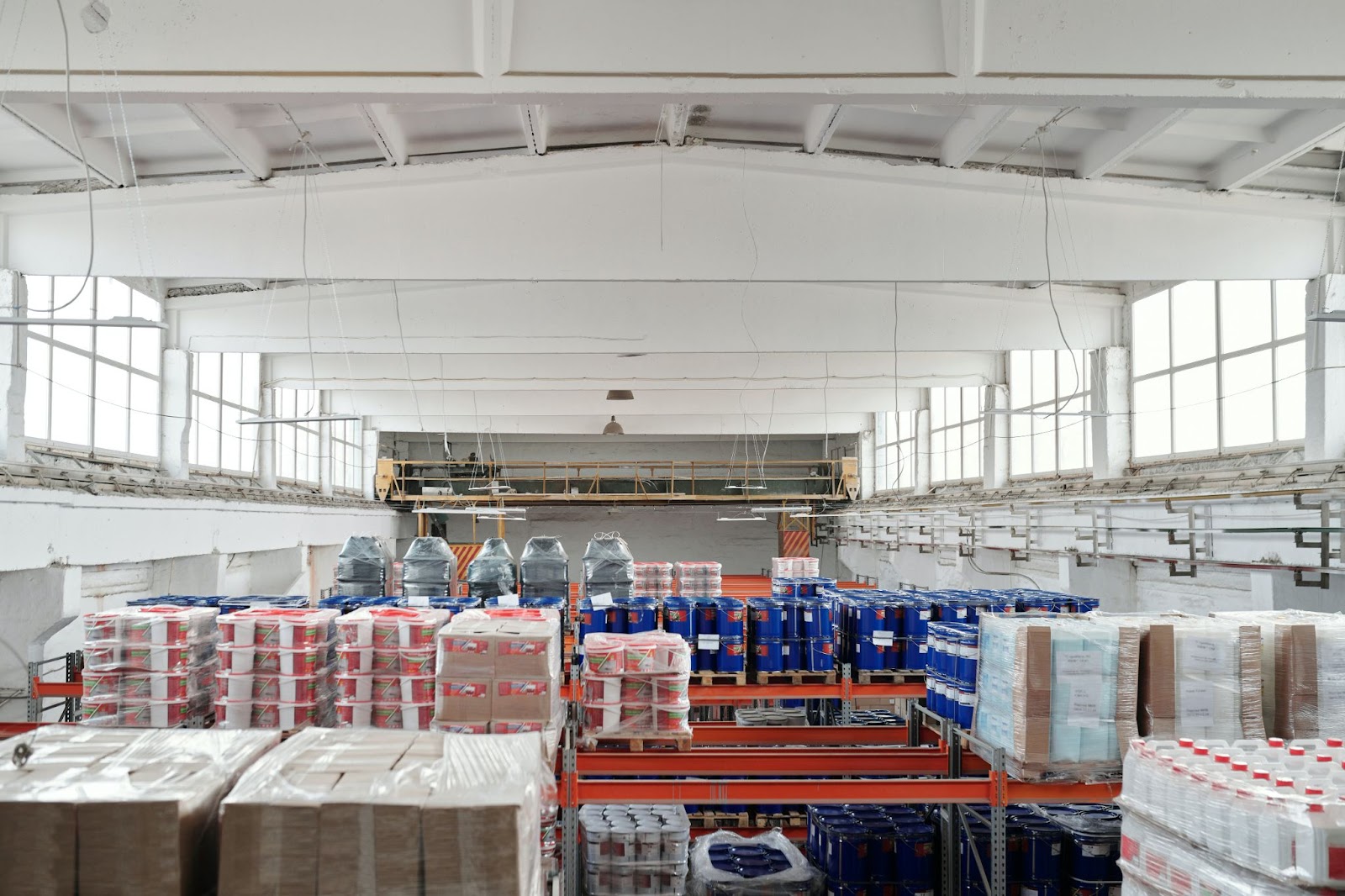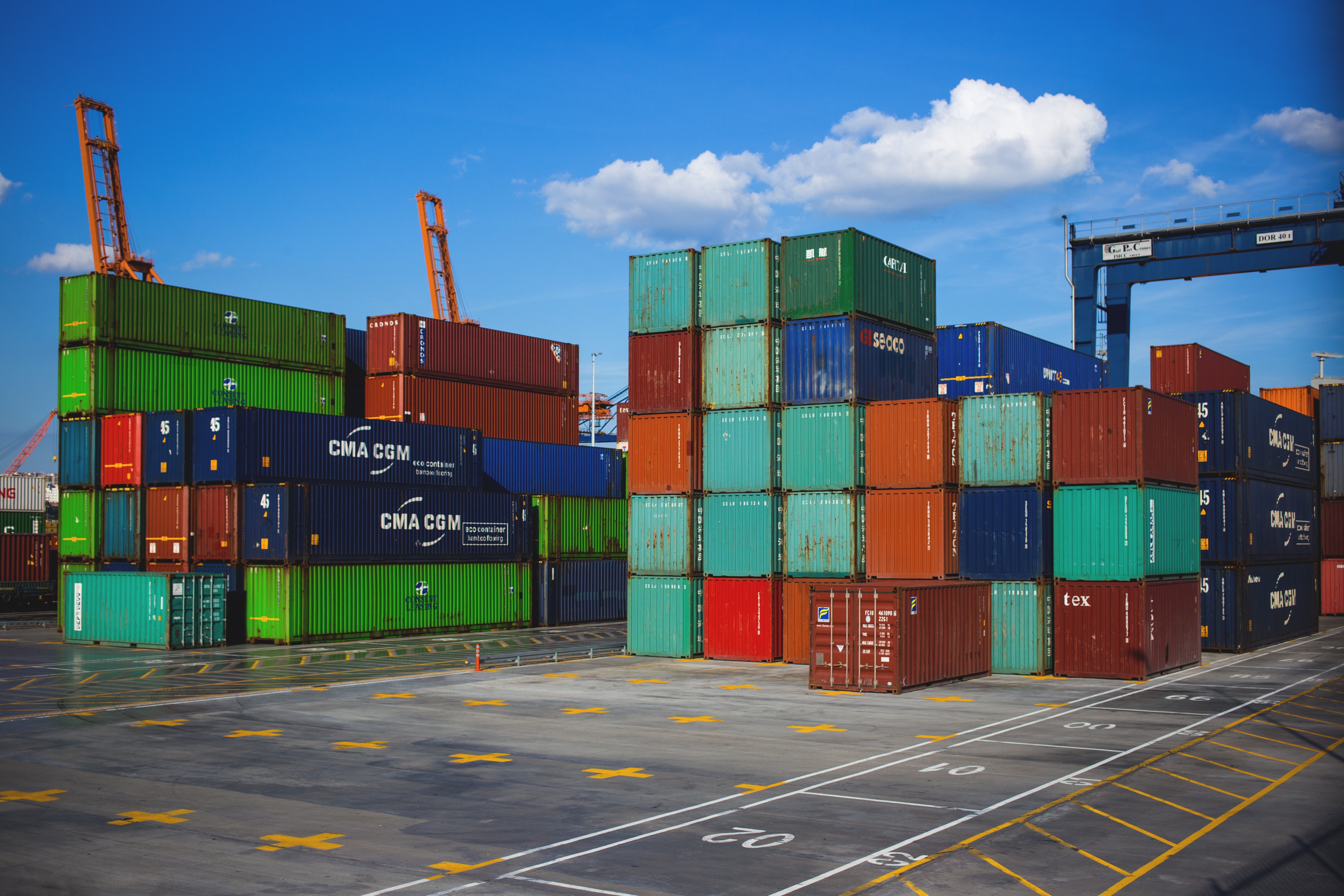Lagerhaltung in der Logistik: Was ist das und wie funktioniert es?
Erfahre, was Warehousing ist und wie Logistik-Warehousing deinem E-Commerce-Unternehmen helfen kann, zu wachsen.
.png)
Die Bedeutung einer reibungslos funktionierenden Supply Chain ist in den letzten zwei Jahren immer deutlicher geworden. Leere Supermarktregale, Lieferverzögerungen und steigende Frachtkosten haben gezeigt, wie wichtig Supply Chains für E-Commerce, das verarbeitende Gewerbe, die Pharmaindustrie und viele andere Sektoren sind.
Da immer mehr Unternehmen die Bedeutung sowohl der Inbound- als auch der Outbound-Logistik erkannt haben, ist Warehousing zu einem zunehmend wettbewerbsorientierten Bereich geworden, so sehr, dass eine Vielzahl von Lagertypen entstanden sind, darunter auch On-Demand-Warehousing-Einrichtungen.
Was ist Warehousing?
Für jede Organisation, die sich mit Supply Chain Management oder Logistik befasst, ist es von entscheidender Bedeutung, dass die Bedeutung von Warehousing vollständig verstanden wird. Warehousing beschreibt die Lagerung physischer Güter vor der Fulfillment.
Die für das Warehousing benötigte Fläche hängt von der Größe des jeweiligen Einzelhandelsunternehmens und der Art der verkauften Produkte ab. Für kleinere Unternehmen kann ein Lagerraum groß genug sein, um alle ihre Warehousing-Anforderungen zu erfüllen. Größere Unternehmen benötigen wahrscheinlich eine maßgeschneiderte Lagereinrichtung.
Auf der Suche nach der richtigen Warehousing-Lösung für ihre Bedürfnisse könnten Unternehmen verschiedene Möglichkeiten in Betracht ziehen. Sie könnten:
- Entscheiden Sie sich für den Bau oder Kauf eines neuen Lagers
- Lagerraum mieten
- Miete eine bestehende Einrichtung
- Nimm die Unterstützung eines Drittanbieters für das Bestandsmanagement im Lager in Anspruch
Für E-Commerce-Unternehmen deckt die Lagerhaltung normalerweise einen bestimmten Teil der Lieferkette ab. In Lagerhäusern werden Produkte gelagert, bis sie von einem Kunde online gekauft werden. Dann werden die Waren vom Lager an den Kunde versandt. Alternativ können auch stationäre Einzelhändler ein Lager nutzen, um überschüssige Produkte zu lagern, bis sie im Laden Platz dafür haben.
Warum ist Warehousing wichtig?
Lagerhäuser bieten einen sicheren Ort, um Waren vor dem Kauf zu lagern, sodass Einzelhändler die Kontrolle über den Standard und die Qualität ihres Inventars behalten können. Für Unternehmen, die verderbliche Waren verkaufen, wie z. B. Kühlwaren, ist dies unerlässlich.
Ein bestimmtes Warenlager kann auch Personal- und Produktivitätsvorteile bieten. Durch die Bereitstellung eines zentralen Standorts für die Lagerung von Produkten können Einzelhändler Bestellungen und ihren Personalbedarf einfacher verfolgen und verwalten. Die Effizienzvorteile der Lagerhaltung können auch die Produktivität des Logistikpersonals steigern und so die Gewinne erhöhen.
Gleichzeitig können die Effizienzvorteile der Lagerung deiner Waren in einem Lagerhaus dazu beitragen, die Lieferzeiten zu verkürzen und die Versandkosten zu senken. Warehousing bietet einen zentralen Punkt, um den herum Unternehmen ihren Fulfillment-Prozess optimieren können.
Eine Möglichkeit zur Verbesserung deiner Warehousing-Prozesse ist der Einsatz digitaler Tools. Warehousing-Technologien wie Warehouse-Management-Systeme und Fulfillment-Software können Lagerbestände überwachen, die Auftragsabwicklung automatisieren und relevante Daten verfolgen, um schlanke Supply Chains zu gewährleisten und Unternehmen den Zugriff auf Echtzeit-Einblicke in ihren Logistikprozess zu ermöglichen.
Angesichts der steigenden Nachfrage im E-Commerce werden in den nächsten fünf Jahren schätzungsweise 300 Millionen Quadratmeter zusätzliche Lagerfläche in ganz Europa benötigt, was die Einzelhändler dazu veranlasst, sich der wichtigen Rolle bewusst zu werden, die diese Einrichtungen innerhalb ihrer gesamten Lieferketten spielen. Da sie sich auf die Lieferzeiten, die Kunde und letztlich auf den Ruf Marke auswirken, beginnen Unternehmen, Lagerhäuser als mehr als nur einen Ort zur Lagerung von Produkten zu betrachten.

Lagerung und Warehousing
Obwohl Lagerung und Warehousing manchmal synonym verwendet werden, sind die beiden Begriffe unterschiedlich. Es stimmt zwar, dass Lagerhäuser zur Lagerung von Produkten verwendet werden, aber die Lagerung kann auch an anderen Orten erfolgen. E-Commerce-Unternehmen verfügen möglicherweise intern über Lagerflächen, während Kunden Waren nach dem Kauf an einem Ort ihrer Wahl lagern.
Lagerhäuser sind eine spezielle Art von Einrichtung, in der neben anderen Funktionen auch Lagerung betrieben wird. Um hervorzuheben, warum Lagerraum für E-Commerce-Unternehmen so wichtig ist, ist es wichtig, das Ausmaß der Waren innerhalb der Supply Chain zu erkennen. Amazon beispielsweise ist allein für 4,2 Milliarden Sendungen pro Jahr verantwortlich. Zwischen Kauf und Lieferung müssen diese Waren irgendwo gelagert werden.
Ein wesentlicher Unterschied zwischen Warehousing und Lagerung besteht jedoch darin, dass Ersteres auch andere Funktionen umfasst. Neben der Lagerung spielt das Warehousing eine Rolle bei der Kapazitätsplanung, dem Einlagern, der Bestandskontrolle, dem Fulfillment und mehr.
Welche Funktionen hat das Warehousing?
Wie bereits erwähnt, ist die Lagerung eine Hauptfunktion des Warehousing, aber auch andere spielen eine wichtige Rolle innerhalb der Supply Chain. Lagerhäuser können beispielsweise zur Preisstabilität beitragen, indem sie es Einzelhändlern ermöglichen, Rohstoffe in Zeiten niedriger Preise zu kaufen. Die Nutzung von Lagerhäusern zur Lagerung von Lagerbeständen kann ein wirksamer Schutz gegen Inflation sein.
Neben dem Schutz vor Inflation bieten Lagerhäuser auch physischen Schutz. Warehousing ermöglicht die sichere Lagerung von Produkten und schützt sie vor Diebstahl oder Beschädigung. Neben den Sicherheitsprotokollen, die auf das Lager selbst angewendet werden, können auch Sensoren zur Überwachung der Umgebung bestimmter Güter eingesetzt werden, um zusätzliche Sicherheit zu bieten.
Warehousing bietet auch finanzielle Vorteile. Produktinhaber können den Wert ihrer Waren oder die Lagereinnahmen nutzen, um zusätzliche Mittel von Finanzinstituten zu erhalten. Wenn Unternehmen zusätzliche Finanzmittel benötigen, bieten einige Banken Kredite an, bei denen eine Lagereinrichtung oder deren Bestand als Sicherheit dient. Lagereinnahmen können auch durch die Vermietung der Immobilie für andere Funktionen erzielt werden. Betrachte das Lager als einen Vermögenswert und nicht als ein Kostenzentrum.
Es ist auch wichtig, den Umsatzschub zu berücksichtigen, der sich aus einer gut funktionierenden Lagereinrichtung ergibt. In Bezug auf die Reorganisation, Verpackung und Sortierung von Lagerbeständen können die vielfältigen Funktionen von Lagerhäusern den Logistikprozess auf ein neues Niveau heben.
Welche Vorteile bietet das Warehousing?
Die Vorteile des Warehousing für den Logistikprozess eines Unternehmens sind vielfältig. Einer der Hauptvorteile ist die verbesserte Bestandsgenauigkeit. Durch die Zentralisierung der Waren eines Unternehmens an einem einzigen Ort wird es einfacher, die Lagerbestände zu bewerten und für die Zukunft zu planen.
In Bezug auf den Personalbestand erhalten Unternehmen auch ein klareres Bild davon, wie viele Mitarbeiter sie zur Verwaltung ihres Lagerbestands benötigen. Unabhängig davon, ob sie Spitzenumsätze oder eine Flaute erleben, erleichtert ein Lagerhaus die Übersicht, wie viele Produkte sich derzeit im Lager befinden und wie viele Mitarbeiter zu deren Verwaltung benötigt werden.
Die zusätzliche Transparenz, die Lagerhäuser bieten, ermöglicht es Unternehmen auch, angemessen zu investieren, um ihre Gemeinkosten zu senken. Ineffizienzen innerhalb der Supply Chain können zu unnötig hohen Kosten führen. Mit einem Lagerhaus wird es einfacher, Engpässe und steigende Kosten zu erkennen, bevor sie beseitigt werden. Dies können ein geringes Produktivitätsniveau, steigende Produktkosten, Mitarbeiterlöhne oder andere Herausforderungen sein.
Lagerhäuser stellen auch einen sicheren Ort für die sichere Lagerung von Waren dar. Für Unternehmen, die verderbliche Waren verwalten, einschließlich Tiefkühlkost oder Pharmazeutika, ist es unerlässlich, dass die Produkte in einer kontrollierten Umgebung aufbewahrt werden. Darüber hinaus kann die Sicherheit mithilfe einer Mischung aus Technologie wie CCTV-Kameras und Alarmanlagen sowie persönlichem Wachpersonal leichter priorisiert werden, um deine Waren zu schützen.
Und schließlich bieten Lagerhäuser einen zentralen Ort, um den herum Unternehmen den Transport ihrer Waren optimieren können. Durch die Wahl des richtigen Standorts für dein Lager kannst du die Zeit verkürzen, die für den Versand von Produkten von Herstellern oder an Kunden benötigt wird. Dies verbessert deinen Warenfluss, optimiert die Lagerverarbeitung und sorgt für eine Supply Chain, die für dich funktioniert.

Arten von Warehousing
Obwohl die Sicherung eines Lagerhauses wie ein einfacher Prozess erscheinen mag, müssen E-Commerce-Unternehmen zunächst entscheiden, welche Art von Lagerhaus sie benötigen. Es gibt verschiedene Arten von Lagerhäusern, darunter:
- Private Lagerhäuser
- Öffentliche Lagerhäuser
- Genossenschaftliche Lagerhäuser
- On-Demand-Lagerhaltung
- Zolllager
- Verteilzentren
Private Lagerhäuser
Private Lagerhäuser werden von privaten Unternehmen genutzt, um ausschließlich von dieser Organisation produzierte Artikel zu lagern. Da die Kosten für den Bau oder Kauf eines Lagerhauses vollständig von privaten Unternehmen getragen werden, kann diese Art von Lagerhaus unerschwinglich teuer sein. Daher wird dies in der Regel nur von den größten Unternehmen als eine praktikable Option angesehen, die einen erheblichen Lagerraumbedarf haben.
Öffentliche Lagerhäuser
Öffentliche Lagerhäuser, auch bekannt als “Duty-Paid-Lagerhäuser”, sind Eigentum von Regierungen oder öffentlichen Einrichtungen und werden privaten Unternehmen gegen eine Gebühr zur Nutzung zur Verfügung gestellt.
Diese Lagerhäuser sind normalerweise mit verschiedenen Lagerdienstleistungen ausgestattet, wie z. B. Sicherheitspersonal, die von Unternehmen genutzt werden können. Sie befinden sich oft an wichtigen Verkehrsknotenpunkten, um sicherzustellen, dass sie sich in der besten Lage für die Mehrheit der Einzelhändler befinden.
Genossenschaftliche Lagerhäuser
Bei der genossenschaftlichen Lagerhaltung besitzen mehrere private Firmen, die sich Lagerraum teilen, die Einrichtungen gemeinsam. Für Unternehmen mit ähnlichen Bestandsanforderungen - wie z. B. verschiedene Weingüter - kann dies eine effektive Möglichkeit sein, Kosten zu teilen und gleichzeitig ein Lagerhaus zu nutzen, das die Qualität der Waren sicherstellt.
On-Demand-Lagerhaltung
Wenn Unternehmen keine fortlaufende Lagerhaltung benötigen, können sie feststellen, dass On-Demand-Lagerhaltung am besten zu ihren Bedürfnissen passt.
On-Demand-Lagerhaltung bedeutet, dass Unternehmen Lagerraum kurzfristig mieten, um beispielsweise einen Nachfrageanstieg zu bewältigen. Der Markt für On-Demand-Lagerhaltung soll bis 2023 25 Milliarden Dollar erreichen, was auf das rasante Wachstum im E-Commerce-Markt und den harten Wettbewerb zwischen Lagerhausbesitzern und -betreibern zurückzuführen ist.
Zolllager
Ein Zolllager ist eine Einrichtung zur Lagerung importierter Waren, während die Zollgebühren noch nicht bezahlt sind. Diese Lagerhäuser können von Regierungen oder privaten Unternehmen betrieben werden (wobei Lizenzen erteilt werden), wobei Zollbeamte eine strenge Aufsicht über alle Produkte ausüben. Sobald die entsprechenden Steuern bezahlt wurden, können die in einem Zolllager gelagerten Waren zu ihrem nächsten Bestimmungsort transportiert werden.
Verteilzentrum
Während die verschiedenen Arten von Lagerhäusern die Lagerung als Hauptzweck haben, ist ein Verteilzentrum etwas anders. Diese Einrichtungen sind darauf ausgelegt, Produkte schnell zu anderen Unternehmen oder Verbrauchern zu transportieren.
Im Gegensatz zu einem Lagerhaus, in dem Waren über längere Zeiträume gelagert werden können, werden in Verteilzentren Produkte in der Regel kurzzeitig gelagert, bevor sie kommissioniert, verpackt und woandershin versandt werden.
Lagerhaltung für E-Commerce
Prognosen zufolge wird der E-Commerce-Umsatz bis 2025 7,4 Billionen US-Dollar erreichen, und die Zahl der Online-Einkäufe steigt kontinuierlich an. Für E-Commerce-Unternehmen stellt dies ein Problem dar. Wie können sie die riesigen Mengen an Waren lagern, um die Nachfrage zu befriedigen, und gleichzeitig die Versandanforderungen erfüllen, Rücksendungen bearbeiten und generell die Erwartungen Kunde erfüllen? Die Antwort liegt im E-Commerce Warehousing.
Das richtige Lager kann Einzelhändler bei der Lagerung von Warenbeständen, dem Versand und der Warenannahme sowie dem gesamten E-Commerce-Geschäft unterstützen. Die Vielseitigkeit der Lagerhäuser, die es in verschiedenen Ausführungen und mit einer Vielzahl von Funktionen gibt, bedeutet, dass es wahrscheinlich eine Einrichtung gibt, die zu deinem Budget, deinen Bedürfnissen und deiner Kunde passt. Ein Lager ist viel mehr als nur ein Lagerraum; die richtigen Lagerverwaltungsinstrumente können sicherstellen, dass dein Lager das Herzstück einer reibungslos funktionierenden Lieferkette ist.
Bei Hive bieten wir eine All-in-One-Lagerlösung, die sich in Ihr Bestandsmanagement, Ihre Verpackungsprozesse und Ihre Last-Mile-Versandpartner integrieren lässt. Nutze die Sicherheits-, Produktivitäts- und finanziellen Vorteile der Lagerhaltung. Nimm noch heute Kontakt mit uns auf.










.png)
.png)
.png)
.png)


.png)
.png)

.png)
.png)
.png)


